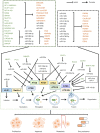Non‑coding RNAs: Role of miRNAs and lncRNAs in the regulation of autophagy in hepatocellular carcinoma (Review)
- PMID: 37083063
- PMCID: PMC10170481
- DOI: 10.3892/or.2023.8550
Non‑coding RNAs: Role of miRNAs and lncRNAs in the regulation of autophagy in hepatocellular carcinoma (Review)
Abstract
The term autophagy describes a process that supports nutrient cycling and metabolic adaptation that is accomplished via multistep lysosomal degradation. These activities modulate cell, tissue and internal environment stability, and can also affect the occurrence and development of cancer. Previous studies have mostly described autophagy as having dual effects in cancer, serving to limit tumorigenesis in the early stages of cancer, but promoting tumor progression in certain types of cancer. There have been indications in recent years that microRNAs (miRNAs/miRs) and long non‑coding RNAs (lncRNAs), as types of non‑coding RNAs, play major roles in the occurrence, invasion, development and drug resistance of hepatocellular carcinoma (HCC) and in the migration of HCC cells by governing HCC cell autophagy. Therefore, understanding which miRNAs and lncRNAs play such roles and the relevant molecular mechanisms is critical. The present review highlights the significant functions of miRNAs and lncRNAs in the regulation of autophagy in HCC and the relevant mechanisms, aiming to provide novel insight into HCC therapeutics.
Keywords: autophagy; hepatocellular carcinoma; long non‑coding RNAs; microRNAs; non‑coding RNAs.
Conflict of interest statement
The authors declare that they have no competing interests.
Figures



Similar articles
-
Roles and Regulation of Long Noncoding RNAs in Hepatocellular Carcinoma.Cancer Res. 2019 Oct 15;79(20):5131-5139. doi: 10.1158/0008-5472.CAN-19-0255. Epub 2019 Jul 23. Cancer Res. 2019. PMID: 31337653 Review.
-
LncRNA XXYLT1-AS2 promotes tumor progression via autophagy inhibition through ubiquitinated degradation of TFEB in hepatocellular carcinoma.Clin Transl Oncol. 2024 Mar;26(3):698-708. doi: 10.1007/s12094-023-03294-3. Epub 2023 Aug 4. Clin Transl Oncol. 2024. PMID: 37540409
-
The mRNA, miRNA and lncRNA networks in hepatocellular carcinoma: An integrative transcriptomic analysis from Gene Expression Omnibus.Mol Med Rep. 2018 May;17(5):6472-6482. doi: 10.3892/mmr.2018.8694. Epub 2018 Mar 7. Mol Med Rep. 2018. PMID: 29512731 Free PMC article.
-
Long non‑coding RNA MKLN1‑AS aggravates hepatocellular carcinoma progression by functioning as a molecular sponge for miR‑654‑3p, thereby promoting hepatoma‑derived growth factor expression.Int J Mol Med. 2020 Nov;46(5):1743-1754. doi: 10.3892/ijmm.2020.4722. Epub 2020 Sep 9. Int J Mol Med. 2020. PMID: 33000222 Free PMC article.
-
Decoding hepatocarcinogenesis from a noncoding RNAs perspective.J Cell Physiol. 2023 Sep;238(9):1982-2009. doi: 10.1002/jcp.31076. Epub 2023 Jul 14. J Cell Physiol. 2023. PMID: 37450612 Review.
Cited by
-
HOXC Cluster Antisense RNA 3, a Novel Long Non-Coding RNA as an Oncological Biomarker and Therapeutic Target in Human Malignancies.Onco Targets Ther. 2023 Oct 24;16:849-865. doi: 10.2147/OTT.S425523. eCollection 2023. Onco Targets Ther. 2023. PMID: 37899986 Free PMC article. Review.
-
Efficacy of stem cells versus microvesicles in ameliorating chronic renal injury in rats (histological and biochemical study).Sci Rep. 2024 Jul 18;14(1):16589. doi: 10.1038/s41598-024-66299-0. Sci Rep. 2024. PMID: 39025899 Free PMC article.
-
Alterations in miRNA Expression and Their Role in the Pathogenesis of Cervical Cancer.Asian Pac J Cancer Prev. 2024 Oct 1;25(10):3533-3541. doi: 10.31557/APJCP.2024.25.10.3533. Asian Pac J Cancer Prev. 2024. PMID: 39471019 Free PMC article.
-
Unveiling the impact of non-coding RNAs on virus-induced cellular autophagy: roles and research advances.Front Microbiol. 2025 Aug 6;16:1632425. doi: 10.3389/fmicb.2025.1632425. eCollection 2025. Front Microbiol. 2025. PMID: 40842844 Free PMC article. Review.
-
Autophagy-associated non-coding RNAs: Unraveling their impact on Parkinson's disease pathogenesis.CNS Neurosci Ther. 2024 May;30(5):e14763. doi: 10.1111/cns.14763. CNS Neurosci Ther. 2024. PMID: 38790149 Free PMC article. Review.
References
Publication types
MeSH terms
Substances
LinkOut - more resources
Full Text Sources
Medical

